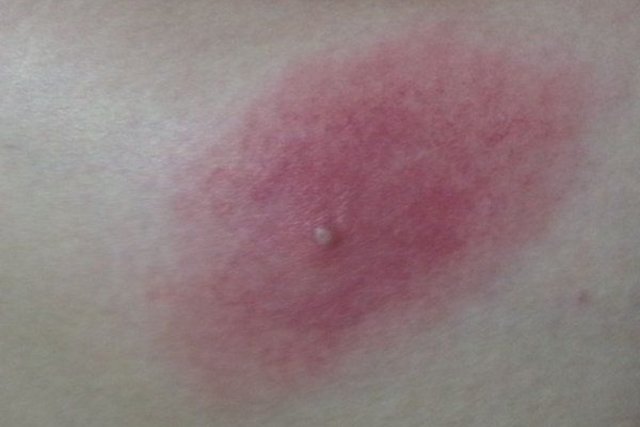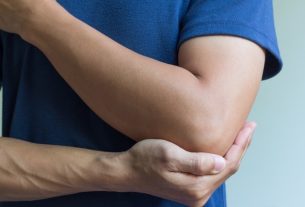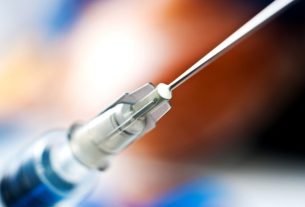A scorpion sting most often causes symptoms such as intense pain in the area of the sting, redness and swelling, however, in some cases they can be more serious, causing generalized symptoms such as dizziness, vomiting, headache, muscle spasms and a drop in blood pressure. arterial.
Scorpion venom is a toxin that acts on the nervous system. The severity of the condition depends on the amount of venom injected and each person’s immune system. If not treated immediately, it can be very dangerous.
In case of a scorpion sting, you should immediately go to the emergency room or call an ambulance and, in the meantime, it is recommended to keep the sting area facing upwards, apply a cold compress to the sting site and drink plenty of water.
Sensitive content
This image may contain content that is uncomfortable for some people.

What to do in case of a scorpion sting
In case of a scorpion sting, you should go to the hospital as quickly as possible or call SAMU on 192, and the first aid measures are:
- Wash the bite site with soap and water;
- Apply cold compresses to the area to delay the absorption of the poison;
- Keep the bite site facing upwards;
- Do not cut, pierce, squeeze or squeeze the bite site;
- Drink plenty of water.
The severity of the sting depends on the amount of venom injected, the type of scorpion and the person’s immune system.
Whenever possible, when stung by a scorpion, you should try to take a photo of the scorpion to help the doctor identify the type of scorpion, facilitating treatment and speeding recovery.
Main symptoms of the bite
The symptoms of a scorpion sting are:
- Severe pain and inflammation at the bite site;
- Redness, swelling and local heat that lasts from a few hours to 2 days;
- Nausea and vomiting;
- Dizziness or headache;
- Tremor and muscle spasms;
- Sweat or paleness;
- Drowsiness or agitation;
- Low blood pressure or high blood pressure;
- Rapid or weak heartbeat;
- Shortness of breathe.
In very rare and serious cases, a scorpion sting can cause arrhythmias, convulsions, a sudden drop in blood pressure, kidney or heart failure, or pulmonary edema, which can be life-threatening if the person is not quickly attended to and treated.
How the treatment is carried out
To relieve pain and inflammation at the site of the bite, it is recommended to apply compresses with cold water, and the doctor may recommend the use of analgesics or anti-inflammatories, such as dipyrone or ibuprofen, for example.
In people with more severe symptoms, it is necessary to use antiscorpion serum, which will be prescribed by the emergency room doctor, to reduce the effect of the poison on the body. In these cases, hydration with saline solution into the vein is also carried out and observation is carried out for a few hours, until the symptoms have disappeared.
How to identify the type of scorpion
The best way to know if the type of scorpion is very poisonous is, if possible, to capture and take the animal to the emergency room for identification. There are around 30 species of scorpion in Brazil, the most dangerous of which are:
- Yellow Scorpio – it is light yellow in color, with darker spots on the back and tail, and measures up to 7 cm in length. It is the most dangerous scorpion, and its sting causes pain and numbness, which can lead to nausea, vomiting, sweating and arrhythmias, especially in children and the elderly.
- Brown Scorpio – it is dark brown or reddish brown in color, with yellow and spotted legs, and measures around 7 cm. It is widely found in humid regions, and its bite causes a lot of pain, numbness, nausea and discomfort.
- Northeast Scorpio – It has a yellowish color, with a darker line in the center, and a small, darker triangle on its head. It generally causes mild symptoms, with pain and numbness at the site of the bite.
- Amazon black scorpion – it is dark in color, almost black, and measures around 8.5cm. Its bite causes intense pain and local inflammation, with a stinging and burning sensation, in addition to being able to cause serious symptoms, such as arrhythmias, dizziness, shortness of breath and drowsiness.
In the case of the Amazonian black scorpion sting, it is dark in color, almost black, and measures around 8.5cm. Its bite causes intense pain and inflammation at the site of the bite with a stinging and burning sensation, in addition to causing serious symptoms such as arrhythmias, dizziness, shortness of breath and drowsiness.
How to avoid a scorpion sting
To prevent scorpion stings, it is recommended to take some precautions at home, such as:
- Keep the house clean, removing accumulations of dirt behind furniture, curtains and carpets;
- Clean the yard or garden to avoid the accumulation of debris and garbage in these places;
- Avoid walking barefoot or putting your hands in holes or cracks;
- Keep animals such as chickens, owls, geese or frogs in the yard, as they are predators of scorpions;
- Inspect clothes and shoes before using them;
- Keep beds away from walls;
- Keep the yard free of weeds;
- Seal the sewage chambers and place metal screens on the kitchen, bathroom and laundry grates, and drains in sinks and bathrooms;
- Do not put your hands in holes, cracks or drawers, which are scorpions’ favorite places;
- Plaster walls, cover cracks or cracks in floors, walls and ceilings;
- Do not accumulate firewood, bricks or debris near the house.
Cleaning is important, as dirty places, with an infestation of cockroaches and rats, for example, more easily attract venomous animals such as scorpions, spiders and snakes. Also know what to do in situations of spider bites and snake bites.
How to catch or kill scorpions
The scorpion is a very difficult animal to eliminate, as it is quite resistant to poisons. This happens because it is an animal that can close its lung stigmata, preventing it from inhaling the venom. Furthermore, it is capable of remaining still for long periods of time, not coming into contact with the poison.
Therefore, it is best to call the authorities as soon as a scorpion is identified, so that it can be captured and taken to specific locations. If you need to capture a scorpion at home, you must:
- Wear long-sleeved pants and shirts;
- Wear thick, rubber boots;
- Wear thick protective gloves, such as electrical gloves;
- Wear a hat;
- Pick up the scorpion with tweezers at least 20 cm long;
- Hold the scorpion by the tail and place it inside a plastic container;
- Close the container with a lid, preferably screw, and with small holes.
However, it is always worth remembering that the scorpion should, whenever possible, be captured by a trained professional, so that accidents do not happen.
Captured scorpions must be handed over to the authorities, preferably alive, not only to avoid the occurrence of a sting, but also so that they can be used to create antidotes.

Sign up for our newsletter and stay up to date with exclusive news
that can transform your routine!
Warning: Undefined array key "title" in /home/storelat/public_html/wp-content/plugins/link-whisper-premium/templates/frontend/related-posts.php on line 12
Warning: Undefined array key "title_tag" in /home/storelat/public_html/wp-content/plugins/link-whisper-premium/templates/frontend/related-posts.php on line 13




